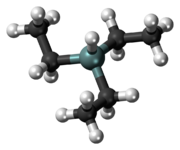Chemistry:Triethylsilane
From HandWiki

| |

| |
| Names | |
|---|---|
| Preferred IUPAC name
Triethylsilane | |
| Identifiers | |
3D model (JSmol)
|
|
| ChemSpider | |
| EC Number |
|
PubChem CID
|
|
| UNII | |
| |
| |
| Properties | |
| C6H16Si | |
| Molar mass | 116.28 g/mol |
| Appearance | colorless liquid |
| Density | 0.728 g/mL |
| Melting point | −156.1 °C (−249.0 °F; 117.0 K) |
| Boiling point | 107–108 °C (225–226 °F; 380–381 K) |
| log P | 3.08 |
| Vapor pressure | 31 hPa at 20 °C 75 hPa at 38 °C 126 hPa at 50 °C |
| Hazards | |
| GHS pictograms | 
|
| GHS Signal word | Danger |
| H225, H412[1] | |
| P210, P273[1] | |
| Flash point | −2.99 °C (26.62 °F; 270.16 K) closed cup[1] |
Except where otherwise noted, data are given for materials in their standard state (at 25 °C [77 °F], 100 kPa). | |
| Infobox references | |
Tracking categories (test):
Triethylsilane is the organosilicon compound with the formula (C2H5)3SiH. It is a trialkylsilane. The Si-H bond is reactive. This colorless liquid is used in organic synthesis as a reducing agent and as a precursor to silyl ethers.[2] As one of the simplest trialkylsilanes that is a liquid at room temperature, triethylsilane is often used in studies of hydrosilylation catalysis.[3]
Additional reading
- Richard T. Beresis, Jason S. Solomon, Michael G. Yang, Nareshkumar F. Jain, and James S. Panek (1998). "Synthesis of Chiral (E)-Crotylsilanes: [3R- AND 3S-]-(4E)-Methyl 3-(Dimethylphenylsilyl)-4-Hexenoate ". Organic Syntheses 75: 78. http://www.orgsyn.org/demo.aspx?prep=v75p0078.
- Alessandro Dondoni and Daniela Perrone (2000). "Diastereoselective Synthesis of Protected Vicinal Amino Alcohols: (S)-2-[(4S)-N-tert-Butoxycarbonyl-2,2-Dimethyl-1,3,-oxazolidinyl]-2-tert-butyldimethylsiloxyethanal from a Serine-Derived Aldehyde ". Organic Syntheses 77: 78. http://www.orgsyn.org/demo.aspx?prep=v77p0078.
- Pape C. (1881). "Über Siliziumpropylverbindungen". Ber 14: 1873. http://gallica.bnf.fr/ark:/12148/bpt6k906939/f283.chemindefer.
- Charles A. Kraus; Walter K. Nelson (1934). "The Chemistry of the Triethylsilicyl Group". J. Am. Chem. Soc. 56 (1): 195–202. doi:10.1021/ja01316a062.
References
- ↑ 1.0 1.1 1.2 Sigma-Aldrich Co., Triethylsilane. Retrieved on 2015-01-30.
- ↑ Fry, James L.; Rahaim, Ronald J.; Maleczka, Robert E. (2007). "Triethylsilane". Encyclopedia of Reagents for Organic Synthesis. doi:10.1002/9780470842898.rt226.pub2. ISBN 978-0471936237.
- ↑ Brookhart, M.; Grant, B. E. (1993). "Mechanism of a cobalt(III)-catalyzed olefin hydrosilation reaction: Direct evidence for a silyl migration pathway". Journal of the American Chemical Society 115 (6): 2151–2156. doi:10.1021/ja00059a008.
 |

